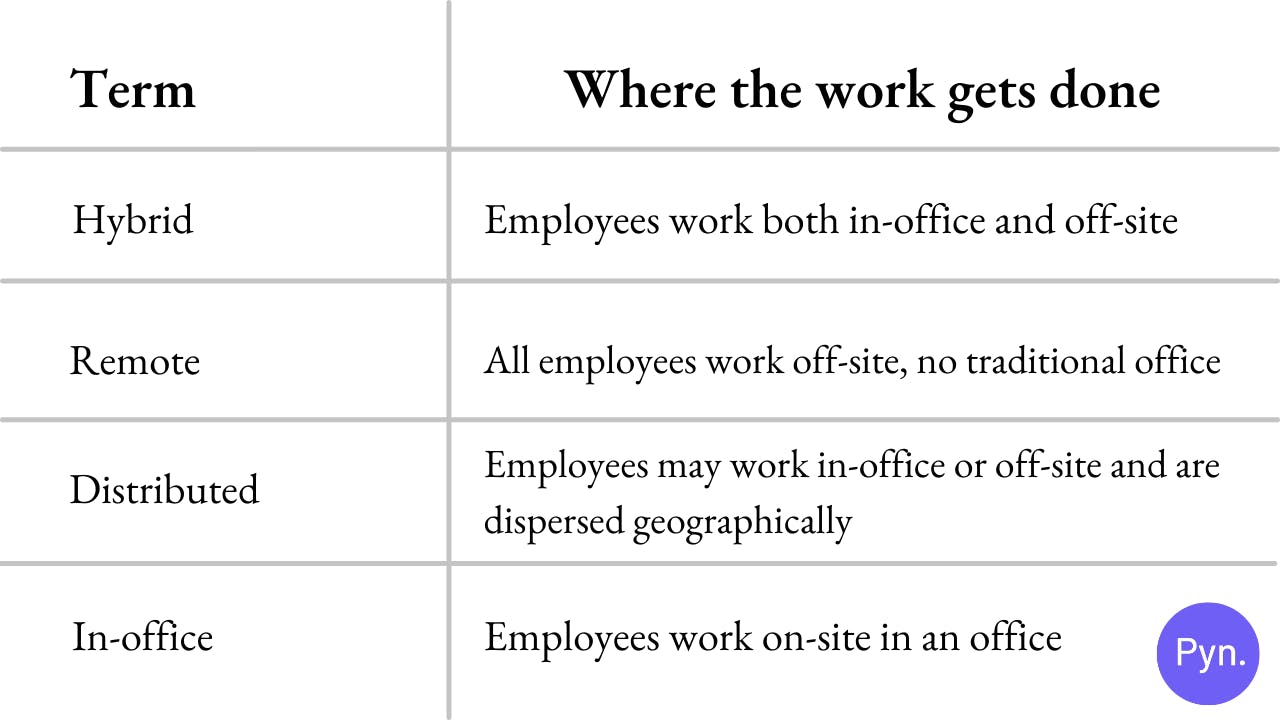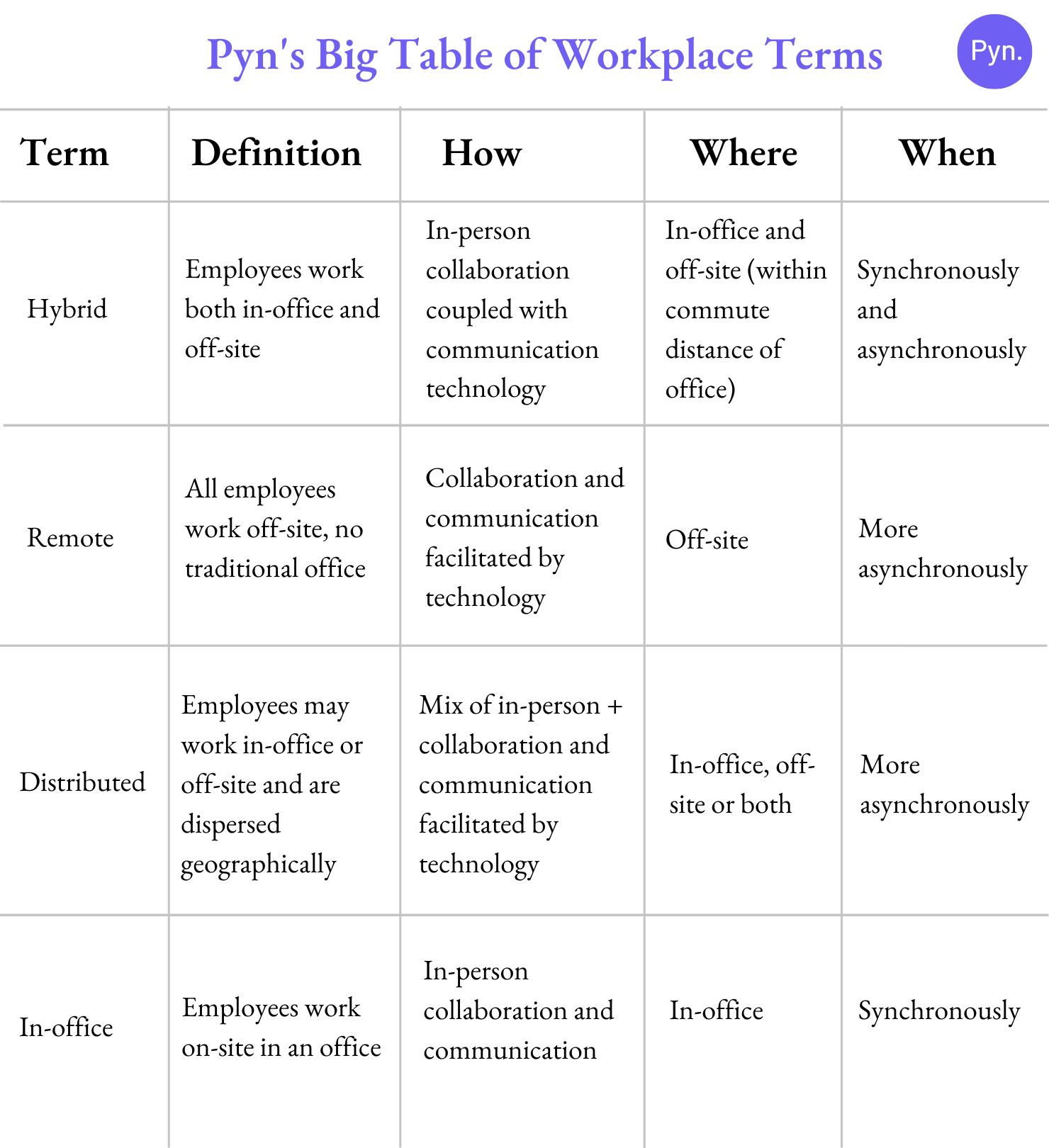
Hybrid, Remote, Distributed: Same Problems, Different Names

Written by
Stacey Nordwall, People and Product
The pandemic provided many of us a crash course in what life is like as a full-time remote worker. There were things to like about the remote working lifestyle like increased schedule flexibility, dedicated time for focused work, and life without a commute. But there were also things like working alone or trying to find the one corner of home undisturbed by roommates or family members for long enough to get through a few video meetings that left a lot to be desired.
In the end, what we discovered was that many of us liked things both about working in the office and about working remotely and wanted to have a mix of both. So when the conversations about returning to the office began, so did the calls for a different approach to work - hybrid work.
But what does hybrid work actually mean? And how different is it from remote or distributed work?
Defining Hybrid Work, Remote Work, and Distributed Work
Generally, when we talk about hybrid, remote and distributed work, we focus on the location - where the work gets done.

But the complexity is far greater than location alone. When it comes down to it, hybrid, remote and distributed work are all about slicing and dicing how, where and when work gets done. Some of which can be dependent on the type of work that has to get done.

The Problem for Hybrid Work: Solving for “when” and “how” work gets done
Most of the challenges faced by hybrid work are not new nor unique. Neither are they entirely based on the location of employees.
Distributed work
Thanks, in part, to advances in communication and collaborative technologies, companies have been growing their distributed workforces for decades. To mitigate time zone differences and employees not all being colocated, enabling a distributed workforce has meant a need to focus on when and how work gets done.
The challenges distributed workforces have been problem-solving for are determining:
- what kinds of work can be done asynchronously,
- what work is best done synchronously and should be planned for any overlap times in schedules, and
- which tools are needed to facilitate communication and collaboration.
Remote work
Similar to distributed companies, companies with a fully remote workforce have also had to focus on how work gets done. To function effectively, they leverage tools and processes that help them communicate and collaborate well asynchronously. But, to a certain extent, they have still faced a “when” and “where” challenge.
Visit most any remote company’s website and you’ll see that many still get together in one location on a regular basis. They do this as an opportunity to create connection, as well as a way to facilitate a period of intense collaboration amongst teams.
Hybrid work
With hybrid work the expectation is that people will come into the office some number of days per week (or month) and work off-site the rest of the time. The initial conversation for hybrid work has focused primarily on when and where work gets done. For example, determining when employees should be in the office and if they should be able to select which days.
Underlying an organization’s desire to give employees the flexibility of when and where they work, is the desire to create a shared understanding of how work will get done. Meaning that work that is considered best done synchronously and in one place, generally collaborative work, should happen in the office.
At its core, this is not very different from the challenges tackled in designing distributed or remote workforces. So, the lessons we have learned from those workforces, particularly the focus on how work gets done, can be examined and applied to hybrid workforce design.
Challenges that may be unique to hybrid work
However, there may be challenges around inclusion and fairness that hybrid workplaces in particular could exacerbate. Particularly - who will be required to come to the office, and given the choice, who is likely to come to the office more often and will they have a career advantage?
For some roles, the when and where is not flexible. The tasks must be done at certain times in a particular location. So a move to hybrid work, especially if not done as part of a larger intentional strategy, can leave those workers feeling treated unfairly.
For more flexible roles, the challenge lies in understanding who will be more or less likely to want to work in the office and what the implications of that may be. For example, research indicates that 50% more women than men with children under 12 and women in general would choose to work from home full-time given the option. Similarly, disabled employees, Black knowledge workers, and employees over 40, who worked remotely during the pandemic are all more likely to choose to work from home more often. This data alone should certainly be an eye-opener and a jumping off point for further research about what experiences these groups have had in the office that might influence their preference to work from home.
Beyond that, it’s also important to understand how the design of hybrid work may then impact their careers over time. Multiple studies have indicated that remote workers are less likely to receive promotions than their counterparts who are in the office. This means that unless companies work to actively counterbalance this effect, they may exacerbate their challenges with creating an inclusive workforce.
What matters: How work gets done and who is thriving
While hybrid workplace design thus far has primarily focused on when and where work gets done, how it gets done and who thrives in each workplace scenario are perhaps the more necessary and important questions to ask. And beyond picking the “right” term to use, it’s important that companies clearly communicate to employees what hybrid, remote, or distributed work means at their organization.
Companies must provide clarity to their employees how much freedom they will have in making decisions about when, where, and how they will work. For example, while a company may want to offer greater flexibility for their employees and describe their workplace as hybrid, remote or distributed, they must be transparent about whether employees will be expected to be in the office and how often. This makes it clear to employees if they need to be within commuting distance of an office location, helps them decide where they might look for services such as day care, and determine what transportation options are available to them.
We can look to remote and distributed workforces, as well as research about the future of work, to better understand how to design a hybrid workplace that addresses when, where and how work gets done. Some companies are approaching this challenge through the development of employee personas. Working in collaboration with employees throughout the organization, these companies are taking a design thinking approach to learning about their employees and then designing a workplace that specifically addresses the needs of each persona.

Stacey loves to hike and read. Her goal is to create inclusive workplaces. Before Pyn, she was an early member of Culture Amp’s people team.
